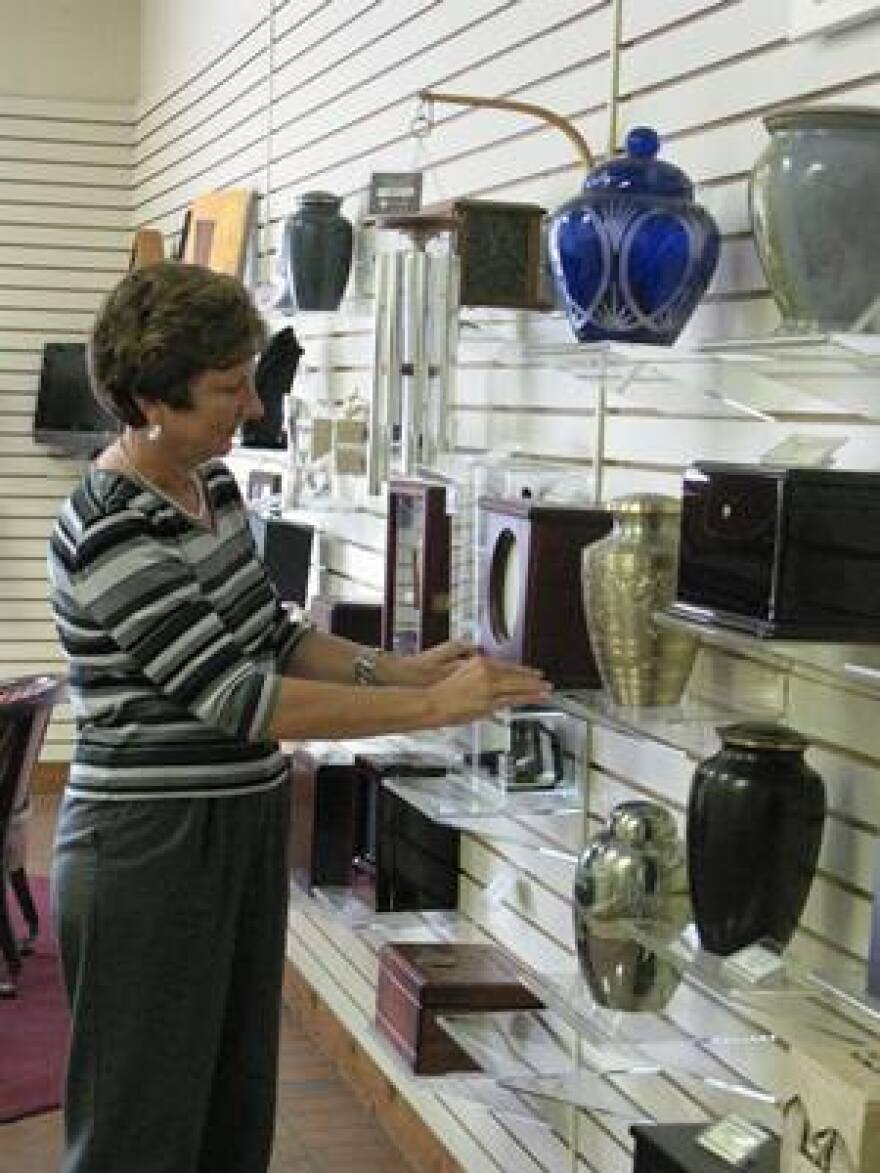By Laura Ziegler
http://stream.publicbroadcasting.net/production/mp3/kcur/local-kcur-977235.mp3
Prairie Village, Kansas – It's a small glass front office on Roe Avenue with a simple sign above the entrance - The Cremation Society.
The name always called to mind other groups I knew little about but invested with some mystery - The Royal Order of Hibernians or The Society of Creative Anachronism.
As it turns out, The Cremation Society is simply a company that helps people arrange cremations. "Families come and they can pre -plan for funeral arrangements, "explained Jeannette Ford, "and then once the cremation is done, then they will come in and pick up cremains, here."
Jeannette Ford is a social worker at The Cremation Society who used to work with hospice patients. And you heard her right. She said "cremains." That's what the remains of a cremation are called. And in a basic cremation, they are returned to the family in a simple, black, plastic container. Ford showed me how the box opens; "Just a plastic container, and cremains come back in sealed bag. Families then sometimes will scatter these, so they just unclip the sealed bag, or they could choose to distribute the remains into several different urns, if different family members wanted."
The walls of an exhibit room adjacent to the office are lined with urns and receptacles of all kinds. Cremains can be put in anything from chimes to urns to boxes. They cost anywhere from under a hundred to several hundred dollars and are made of everything from marble to mahogany. Popular today, Ford says, is jewelery in which a loved one's remains can be worn.
A case displays bracelets and heart lockets, and small pendants of glass with a drift of particles embedded inside; "Are those actually human remains?" I ask. "Yes, and so are these," Ford explains, holding a few of the other necklaces, and a large glass paper weight. "They allow (loved ones)to keep Mom, Dad, Grandma close to them. And these actually carry cremains in them. It's a tube that opens up. Most of the time people ask that we seal them and we do."
There's a common perception that people care less if they choose cremation over a traditional funeral, says Ford. She says that's not been her experience; "One woman asked that the cremains be divided into 10 bags. She said she and her husband had 10 trips planned as so she was gonna take a bag on each trip and leave a little bit of him behind."
The literature on cremation indicates many families today are choosing it for economic reasons - a basic cremation costs about $1,000, significantly less than most traditional funerals.
Others choose cremation because it's environmentally friendly. An Atlanta - based company advertises "eco - friendly reef balls." Remains go into what the company calls "a Swiss-cheese like ball," and dropped in the ocean to foster new marine growth and replenish the world's diminishing reef system.
Whatever the reason, cremation has become increasingly popular in recent years. Between 1985 and 2005, the dead who were cremated jumped from almost 16% to almost 56%, according to the Cremation Association of North America. In Canada today, more people are cremated than not.
And as families spread out - cremains are traveling, too, says Jeannette Ford; "You know we have a lot of people transport cremains. They transport them on the plane. We give them a permit that if they do get stopped, the boxes can be X-rayed."
I asked what the exactly the permit says."Basically," Ford explained, "that 'herin are the cremated remains of...and the the deceased person's name...that were cremated on this date.'" "And that's allowed?" "They don't' let you check it, they want you to carry it on.They don't want it to get lost."
There are several cremation companies in the area, and most funeral homes have crematories, too.
When Jeannette Ford worked for hospice she offered an alternative end-of-life experience to the dying. Now, as a social worker at The Cremation Society, she believes she's offering an alternative to loved ones,once a death has occurred.
Hear other stories and suggest ideas for the What is That? series on the KC Currents page.


